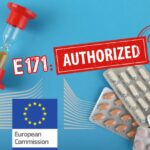
Risks associated with silica nanoparticles

Risks associated with silica nanoparticles
By the AVICENN team – Last updated November 2024
General information: increasingly documented adverse effects
Risks, classification and evaluation
Silica nanoparticles (SiO2) are used in a wide range of applications: in the food industry, cosmetics, pharmaceuticals, diapers and sanitary napkins, but also elastomers, resins, paints, inks, etc.
As confirmed by the annual assessments of the French declaration of substances in the nanoparticulate state published since the end of 2013, various nanoforms of silica are imported or produced in France.
The potentially harmful effects of silica nanoparticles on health1See the references listed at the bottom of the page, section “elsewhere on the web” are increasingly documented.
In 2021, silica nanoparticles were identified as one of the four categories of most hazardous nanoparticles by a team from University College Dublin2Cf. A semiquantitative risk ranking of potential human exposure to engineered nanoparticles (ENPs) in Europe, Li, Y and Cummins, E, Science of the Total Environment, 778, July 2021.
At the end of 2023, ECHA published the Dutch proposal to classify silica nanoparticles as STOT RE 1, H372: risk of serious effects to organs (or a specific organ) through repeated or prolonged exposure3Cf. https://echa.europa.eu/fr/registry-of-clh-intentions-until-outcome/-/dislist/details/0b0236e1809d3513.
As early as 2014, the French Health Safety Agency (ANSES) had advocated a classification of silica dioxide nanoparticles in the CLP Regulation so that measures to restrict or even ban the use of certain consumer applications could be put in place.
The assessment of silica dioxide and its nanoforms by the Netherlands was initially planned for 2012 under REACH, as part of the “Community Continuous Action Plan” (CoRAP) of the European Chemicals Agency (ECHA). It was launched in 20144Cf. Community rolling action plan (CoRAP) update covering years 2014, 2015 and 2016, ECHA, March 2014 but was not successful due to insufficient data from silica manufacturers.
In March 2015, ECHA requested more information from industrialists on the silica nanoforms they manufacture, in order to complete the evaluation of these substances5DECISION ON SUBSTANCE EVALUATION PURSUANT TO ARTICLE 46(1) OF REGULATION (EC) NO 1907/2006 For Silicon dioxide, CAS No 7631-86-9 (EC No 23 1-545-4), March 2015. However, in June 2015, ECHA’s “Board of Appeal” was notified of 2 appeals by nanosilica manufacturers refusing to give the requested information: one from Grace (Germany)6Announcement of appeal – Grace GmbH & Co. KG, ECHA, August 2015: “The Agency has based its decision very largely on its own classification of SAS as a nanomaterial, a classification that the Agency is not empowered to make and that in any event is irrelevant to the toxicity of SAS; (d) The Contested Decision is disproportionate in that it is not appropriate or necessary to achieve the objective of protecting human health, and places an unduly heavy burden on the Appellants”, and the other from a group of 35 companies7Announcement of appeal – Evonik Degussa GmbH and others, ECHA, August 2015: “On 29 February 2012, silicon dioxide was included on the CoRAP due to initial grounds for concern relating to ‘the substance characterisation, nanoparticles and toxicity of different forms of the substance’. The Appellants claim, however, that none of those alleged grounds for concern are criteria for inclusion of a substance on the CoRAP. The Appellants argue that as a result the Agencys decision to include the substance on the CoRAP was adopted in breach of Article 44 of the REACH Regulation and must be set aside. (…) The Appellants claim that the mere fact that the substance meets the non-legally binding definition of ‘nanomaterials’ in Commission Recommendation 2011/696/EU on the definition of nanomaterial is not sufficient to justify the requests for information in the Contested Decision. By requesting information on the substance on the grounds that the substance meets the non-legally binding definition of ‘nanomaterials’ in the Commission Recommendation, the Agency failed to identify a valid concern that needs to be addressed through the substance evaluation procedure.”
In addition to the French companies mentioned above, the signatories were companies :
– German: Evonik Degussa GmbH, Evonik Industries AG, Akzo Nobel Chemicals GmbH, BASF SE, Cabot Aerogel GmbH, Cabot GmbH, Clariant Produkte (Deutschland) GmbH, Grace Silica GmbH, Johnson Matthey Chemicals GmbH, Merck KGaA, Wacker Chemie AG
– Spanish: Evonik Silquilmica SA, IQESIL S.A, Instituto Suizo Para el Fomento de la Seguridad Swissi-España, S.L.U
– Belgium: Evonik Degussa Antwerpen NV, SCAS Europe S.A./N.V, Specialty Chemicals Coordination Center SA/NV
– Swedish: Akzo Nobel Pulp and Performance Chemicals AB
– Finland: Akzo Nobel Finland OY, Albemarle Europe Sprl, J.M. Huber Finland OY
– Dutch: Albermarle Catalysts Company B.V., PPG Industries Chemicals BV
– UK: Cabot Carbon Limited, LSR Associates Ltd, PQ Silicas UK Ltd, PPG CENTRAL (UK) Ltd.
– Italian: Deltagran Europe srl, Silysiamont SpA, Solvay Solutions Italia SpA
– Greek : Hellenic Petroleum SA
See also: 35 firms fight Echa decision on nano silicon dioxide, Chemical Watch, August 2015. Four companies based in France were among the signatories (Evonik Aerosil France Sarl, Clariant Production S.A.S, Merck Performance Materials SAS, Rhodia Operations SAS).
A March 2015 ECHA document states that a possible underestimation of hazards cannot be ruled out based on the data provided by silica manufacturers, who are called upon to clarify their information. The current status of this case is not very clear.
Silica nanoparticles are likely to carry genotoxic agents on their surface which aggravate their harmful effects on DNA8See Dussert F et al, Toxicity to RAW264.7 Macrophages of Silica Nanoparticles and the E551 Food Additive, in Combination with Genotoxic Agents, Nanomaterials, MDPI, 10 (7): 1418, 2020.
The results of a Silimmun research project conducted by French researchers and presented in 2021, show also that amorphous silica nanoparticles, while not displaying the sustained pro-inflammatory character of crystalline silica, do exhibit marked effects on the cells of the immune system which could lead to a deregulation of immune responses. However, the subject is far from being fully explored. In particular, genotoxicity should be analyzed in detail with respect to the internalization capacity of silica vs. the intrinsic defense of cells against genotoxic stress9See The effects of amorphous silica nanoparticles on the immune system, Thierry Rabilloud, The Research Papers. Health, Environment, WorkANSES, 2021, Microplastics and nanomaterials, pp.17-19, 2021.
In May 2024, researchers showed that even when filtered by the placenta and not reaching the embryo or fetus, nanoparticles of titanium dioxide (TiO2) and silica (SiO2) pose health risks for the unborn child, in particular poor blood vessel development. These results confirm the need – and urgency – to exercise great caution when considering using these nanoparticles10Voir :
– our article Titanium dioxide and silica nanoparticles: risks in pregnancy,VeilleNanos, June 2024,
– EMPA press release: Nanoparticles: Risk for babies in the womb, 6 June 2024
– the scientific article Nanoparticles Dysregulate the Human Placental Secretomewith Consequences on Angiogenesis and Vascularization, Dugershaw-Kurzer B et al., Adv. Sci., 11, 2401060, 2024.
Note: scientific studies have confirmed that the smallest amorphous silica particles are generally more toxic than larger ones11Voir par exemple The size-dependent in vivo toxicity of amorphous silica nanoparticles: A systematic review, Miao C et al., Ecotoxicology and Environmental Safety, 271, 115910, February 2024, they also showed a more counter-intuitive result: some nanosilicas are more genotoxic at low doses than at high doses12See in particular:
– Results of the European program Nanogenotox on the genotoxicity of nanomaterials, presented in French at ANSES, during the Restitution of the national research program environment health work: Chemical substances and nanoparticles: models for the study of exposures and health effects: Participant file and Slide show, November 2013.
– ‘Facilitating the safety evaluation of manufactured nanomaterials by characterising their potential genotoxic hazard’, Nanogenotox, 2013
– Papers presented at the meeting of the risk assessment and research office for the Netherlands Consumer Product Safety Authority (NVWA) in October 2013.
Aggregates should not necessarily be considered less toxic than primary particles
In early 2020, the results of research conducted in Belgium showed that aggregates larger than 100 nm should not necessarily be considered less toxic than their nanoscale counterparts13Cf. Assessing the Toxicological Relevance of Nanomaterial Agglomerates and Aggregates Using Realistic Exposure In Vitro, Murugadoss S et al, Nanomaterials, 11, 1793, 2021 and Is aggregated synthetic amorphous silica toxicologically relevant, Murugadoss S et al, Particle and Fibre Toxicology, 17(1), 2020.
Specific risks of silica for different applications
Specific risks of silica in cosmetics
Regarding cosmetics, the Scientific Committee on Consumer Safety (SCCS) reported in September 2015 that data was too disparate, inadequate and insufficient to be able to draw any conclusion concerning the safety of silica nanoforms14Opinion on Silica, Hydrated Silica, and Silica Surface Modified with Alkyl Silylates (nano form), Scientific Committee on Consumer Safety (SCCS), September 2015.
In 2019, the SCCS issued an opinion stating that none of the SAS materials (hydrophilic or hydrophobic) included in the dossier can be considered soluble15Cf. Opinion on solubility of Synthetic Amorphous Silica (SAS), Scientific Committee on Consumer Safety (SCCS), June 20-21, 2019 (corrigendum December 6, 2019).
In 2021, the same committee concluded again that “there is a basis for concern that the use of SAS materials can pose a health risk to the consumer”16Cf. Scientific advice on the safety of nanomaterials in cosmetics, SCCS, 2021 (annex IV).
Specific risks of silica in food
Since at least 2011, it has been known that dietary silica (E551) contains nanoparticles, and researchers have estimated that we consume 124 mg of nano-silica per day.
In October 2024, the European Food & safety agency (EFSA) published scientific opinion on E551
17Cf. Re-evaluation of silicon dioxide (E 551) as a food additive in foods for infants below 16 weeks of age and follow‐up of its re‐evaluation as a food additive for uses in foods for all population groups, EFSA, 17 October 2024 stating that this food additive, made of amorphous silica nanoparticules does not raise a safety concern.
However, as EFSA explicitly highlights it in its report, major uncertainties remain: there are limited toxicological studies, and the studies considered can inform on the potential toxicity of nanosize aggregates/agglomerates only to a limited extent. EFSA also considers that effects of E551 in predisposing to food allergy and autoimmune-mediated coeliac diseases, deserves further investigation, particularly in humans18See our article Silica nanoparticles could promote gluten intolerance, VeilleNanos, June 2024. Cf. Evaluating the Effects of Chronic Oral Exposure to the Food Additive Silicon Dioxide on Oral Tolerance Induction and Food Sensitivities in Mice, Lamas B. et al., Environmental Health Perspectives, 132, 2, 2024, DOI : 10.1289/EHP12758 .
The precautionary principle should therefore lead to more research on this subject and, pending the results, for amorphous silica nanoparticles to be used only in applications where the benefit/risk balance is genuinely favorable from a societal point of view.
Actually, publications showing harmful effects associated with silica ingestion have now been accumulating for several years, with, among other things, evidence of adverse effects of silica nanoparticles ingestion, notably on the liver, intestines and kidneys, the immune system, and cell division and trafficking.
The first nano substance authorized as a biocide
In April 2014, the synthetic amorphous silica nano dioxide became the first (and until the end of 2016 at least, the only) nano substance to have been approved for marketing as a biocidal substance as of November 1, 201519 COMMISSION EXECUTIVE REGULATION (EU) No 408/2014 approving synthetic amorphous silicon dioxide as an existing active substance for use in biocidal products of product-type 18, 23 April 2014.
See also our info sheet What regulation of nanomaterials in biocides in Europe?.
The antibacterial properties of silica, sought after for certain targeted applications, can have undesirable effects on certain bacterial communities necessary for the health or balance of ecosystems. Vigilance is therefore required.
And in the medical field?
In the medical field, a paper published on January 28, 2019, in Nature Nanotechnology shows that silica dioxide nanoparticles can induce changes in the endothelium and thus leakage of tumor cells, which causes metastasis. According to Frédéric Lagarce, professor of biopharmacy and hospital practitioner in Angers: “What is interesting / original is to show a potential risk of nanotechnologies in the treatment of tumors while these technologies are often presented as the answer to improve the performance of anticancer drugs. It is now necessary to verify if these endothelial modifications are also found with polymeric or lipidic nanoparticles, which are much more used to encapsulate active ingredients and target tumors. If this were unfortunately the case, the whole strategy of nanomedicine (very cancer-oriented) would be compromised.
Workers are the first to be exposed
In April 2019, as part of an occupational health research project, INRS issued a call to companies using nanostructured amorphous silica. There were apparently only few candidates because INRS relaunched a new identical call in September 2021…
In May 2019, the French National Health Security Agency (Anses) warned of the high health risks associated with crystalline silica, including quartz, particularly for the 365,000 workers exposed to it. The risks of amorphous silicas are particularly important, because of their nanometric size. Anses recommends a series of measures in terms of prevention and control of exposure in the workplace, medical surveillance and recognition of occupational diseases.
In February 2022, INRS published a specific safety sheet on synthetic amorphous silicas which outlines the prevention and protection measures to be implemented to protect workers.
In French :
– Synthetic amorphous silicas, Fiche pratique de sécurité, ED 153, INRS, February 2022
– Impact of the environment on the β-lactam-recognizing T-cell response: roles in allergic mechanisms, Alexia Feray. Toxicology. Université Paris-Saclay, 2021
– State of knowledge on the “toxicity of nanostructured amorphous silicas, Radauceanu A et al, Références en santé au travail n° 160, TP36, INRS, December 2019
– Hazards, exposures and risks related to crystalline silica, Anses, April 2019 (published in May 2019)
– Hazards, exposures and risks related to crystalline silica, Anses, April 2019 (published in May 2019)
– AVICENN, Nanomaterials and risks to health and the environment – Soyons Vigilants !, éditions Yves Michel, February 2016
– Francelyne Marano, Faut-il avoir peur des nanos ?, Buchet Chastel, April 2016
– “Internalization and translocation of silica oxide and titanium oxide nanoparticles in bronchial epithelial, pulmonary endothelial, and muscle cells” by Mornet S et al. in Participant’s file prepared for the Restitution of the National Environmental Health and Work Research Program (PNREST), October 2015
– Evaluation of the risks associated with nanomaterials – Issues and knowledge update, ANSES, April 2014 (online May 15, 2014)
– Risk assessment of nanomaterials for the general population and the environment (chapter 6.6: Food products and silica), Afsset (now ANSES), March 2010
In English:
– Influence of Critical Parameters on Cytotoxicity Induced by Mesoporous Silica Nanoparticles, Ahmadi A et al, Nanomaterials, 12 (12), 2022
– Silica nanoparticles induce cardiac injury and dysfunction via ROS/Ca2+/CaMKII signaling, Qi Y et al, Science of The Total Environment, 2022
– Synthetic Amorphous Silica Nanoparticles Promote Human Dendritic Cell Maturation and CD4+ T-Lymphocyte Activation, Feret A et al, Toxicological Sciences, Oxford University Press (OUP), 185 (1): 105-116, 2022
– Adverse effects of amorphous silica nanoparticles: Focus on human cardiovascular health, Guo C et al, Journal of Hazardous Materials, 406(15), 124626, 2021
– The Size-dependent Cytotoxicity of Amorphous Silica Nanoparticles: A Systematic Review of in vitro Studies, Dong X et al, Int J Nanomedicine, 15: 9089-9113, November 2020
– Silica nanoparticles induce endoplasmic reticulum stress response and activate mitogen activated kinase (MAPK) signalling, Toxicol Rep, Christen V and Fent K, 3:832-840, November 2016
– Critical review of the safety assessment of nano-structured silica additives in food, Winkler HC et al, Journal of Nanobiotechnology, 14:44, 2016
– Critical assessment of toxicological effects of ingested nanoparticles, McCracken C et al, Environ. Sci.: Nano, 3, 256-282, 2016
– Oxidative stress, inflammation, and DNA damage in multiple organs of mice acutely exposed to amorphous silica nanoparticles, Nemmar A et al, Int J Nanomedicine, 11: 919-928, 2016
– Biodistribution, excretion, and toxicity of mesoporous silica nanoparticles after oral administration depend on their shape, Li L et al, Nanomedicine: Nanotechnology, Biology and Medicine, 11(8): 1915-1924, November 2015
– Genotoxicity of synthetic amorphous silica nanoparticles in rats following short-term exposure. Part 1: Oral route, Tarantini A et al, Environmental and Molecular Mutagenesis, 56 (2): 18-227, March 2015
– Genotoxicity of synthetic amorphous silica nanoparticles in rats following short-term exposure, part 2: Intratracheal instillation and intravenous injection, Guichard Y et al, Environmental and Molecular Mutagenesis, 56 (2): 228-244, March 2015
– Toxicity, genotoxicity and proinflammatory effects of amorphous nanosilica in the human intestinal Caco-2 cell line, Tarantini A et al, Toxicology in Vitro, 29(2): 398-407, March 2015
– Novel insights into the risk assessment of the nanomaterial synthetic amorphous silica, additive E551, in food, van Kesteren PCE et al, Nanotoxicology, 2014
– Kinetics of silica nanoparticles in the human placenta, Poulsen MS et al, Nanotoxicology, July 2013but also on the environment. See for example:
– Physiological and Behavioral Effects of SiO2 Nanoparticle Ingestion on Daphnia magna, Kim Y et al, Micromachines (Basel), 12(9): 1105, September 2021
– Inhibition of total oxygen uptake by silica nanoparticles in activated sludge, Journal of Hazardous Materials, 283(11): 841-846, February 2015
Any questions or comments? This information sheet compiled by AVICENN is intended to be completed and updated. Please feel free to contribute.
Our information sheets to go further
Upcoming Nano Agenda

- Scientific conference
- 23rd International conference on Advanced Nanomaterials
- From July 23 to July 25, 2025
- Website: www.advanced-nanomaterials-conference.com

- E-learning program: awareness-raising for personnel who come into contact with nanomaterials during research, formulation, production, maintenance, cleaning, upkeep, etc., as well as safety coordinators or engineers, facility managers, heads of laboratories where nanoparticles are handled.
- Organizers: INSTN Grenoble (CEA)
- On the program:
- 1 – Introduction, definition and characteristics of nanomaterials
- 2 – Toxicity of nanomaterials: the state of knowledge
- 3 – Metrology and characterization of nanomaterials
- 4 – Prevention and protection against nanomaterials in the workplace
- 5 – Quiz: assessment of learning outcomes
- The 2-hour course can be viewed for one month from the date of registration.
- Website: https://instn.cea.fr/…risques-lies-aux-nanomateriaux…

- E-learning program: awareness-raising for personnel who come into contact with nanomaterials during research, formulation, production, maintenance, cleaning, upkeep, etc., as well as safety coordinators or engineers, facility managers, heads of laboratories where nanoparticles are handled.
- Organizers: INSTN Grenoble (CEA)
- On the program:
- 1 – Introduction, definition and characteristics of nanomaterials
- 2 – Toxicity of nanomaterials: the state of knowledge
- 3 – Metrology and characterization of nanomaterials
- 4 – Prevention and protection against nanomaterials in the workplace
- 5 – Quiz: assessment of learning outcomes
- The 2-hour course can be viewed for one month from the date of registration.
- Website: https://instn.cea.fr/…risques-lies-aux-nanomateriaux…
File initially put on line in May 2016
Notes and references
- 1See the references listed at the bottom of the page, section “elsewhere on the web”
- 2Cf. A semiquantitative risk ranking of potential human exposure to engineered nanoparticles (ENPs) in Europe, Li, Y and Cummins, E, Science of the Total Environment, 778, July 2021
- 3
- 4
- 5
- 6Announcement of appeal – Grace GmbH & Co. KG, ECHA, August 2015: “The Agency has based its decision very largely on its own classification of SAS as a nanomaterial, a classification that the Agency is not empowered to make and that in any event is irrelevant to the toxicity of SAS; (d) The Contested Decision is disproportionate in that it is not appropriate or necessary to achieve the objective of protecting human health, and places an unduly heavy burden on the Appellants”
- 7Announcement of appeal – Evonik Degussa GmbH and others, ECHA, August 2015: “On 29 February 2012, silicon dioxide was included on the CoRAP due to initial grounds for concern relating to ‘the substance characterisation, nanoparticles and toxicity of different forms of the substance’. The Appellants claim, however, that none of those alleged grounds for concern are criteria for inclusion of a substance on the CoRAP. The Appellants argue that as a result the Agencys decision to include the substance on the CoRAP was adopted in breach of Article 44 of the REACH Regulation and must be set aside. (…) The Appellants claim that the mere fact that the substance meets the non-legally binding definition of ‘nanomaterials’ in Commission Recommendation 2011/696/EU on the definition of nanomaterial is not sufficient to justify the requests for information in the Contested Decision. By requesting information on the substance on the grounds that the substance meets the non-legally binding definition of ‘nanomaterials’ in the Commission Recommendation, the Agency failed to identify a valid concern that needs to be addressed through the substance evaluation procedure.”
In addition to the French companies mentioned above, the signatories were companies :
– German: Evonik Degussa GmbH, Evonik Industries AG, Akzo Nobel Chemicals GmbH, BASF SE, Cabot Aerogel GmbH, Cabot GmbH, Clariant Produkte (Deutschland) GmbH, Grace Silica GmbH, Johnson Matthey Chemicals GmbH, Merck KGaA, Wacker Chemie AG
– Spanish: Evonik Silquilmica SA, IQESIL S.A, Instituto Suizo Para el Fomento de la Seguridad Swissi-España, S.L.U
– Belgium: Evonik Degussa Antwerpen NV, SCAS Europe S.A./N.V, Specialty Chemicals Coordination Center SA/NV
– Swedish: Akzo Nobel Pulp and Performance Chemicals AB
– Finland: Akzo Nobel Finland OY, Albemarle Europe Sprl, J.M. Huber Finland OY
– Dutch: Albermarle Catalysts Company B.V., PPG Industries Chemicals BV
– UK: Cabot Carbon Limited, LSR Associates Ltd, PQ Silicas UK Ltd, PPG CENTRAL (UK) Ltd.
– Italian: Deltagran Europe srl, Silysiamont SpA, Solvay Solutions Italia SpA
– Greek : Hellenic Petroleum SA
See also: 35 firms fight Echa decision on nano silicon dioxide, Chemical Watch, August 2015 - 8See Dussert F et al, Toxicity to RAW264.7 Macrophages of Silica Nanoparticles and the E551 Food Additive, in Combination with Genotoxic Agents, Nanomaterials, MDPI, 10 (7): 1418, 2020
- 9See The effects of amorphous silica nanoparticles on the immune system, Thierry Rabilloud, The Research Papers. Health, Environment, WorkANSES, 2021, Microplastics and nanomaterials, pp.17-19, 2021
- 10Voir :
– our article Titanium dioxide and silica nanoparticles: risks in pregnancy,VeilleNanos, June 2024,
– EMPA press release: Nanoparticles: Risk for babies in the womb, 6 June 2024
– the scientific article Nanoparticles Dysregulate the Human Placental Secretomewith Consequences on Angiogenesis and Vascularization, Dugershaw-Kurzer B et al., Adv. Sci., 11, 2401060, 2024 - 11Voir par exemple The size-dependent in vivo toxicity of amorphous silica nanoparticles: A systematic review, Miao C et al., Ecotoxicology and Environmental Safety, 271, 115910, February 2024
- 12See in particular:
– Results of the European program Nanogenotox on the genotoxicity of nanomaterials, presented in French at ANSES, during the Restitution of the national research program environment health work: Chemical substances and nanoparticles: models for the study of exposures and health effects: Participant file and Slide show, November 2013.
– ‘Facilitating the safety evaluation of manufactured nanomaterials by characterising their potential genotoxic hazard’, Nanogenotox, 2013
– Papers presented at the meeting of the risk assessment and research office for the Netherlands Consumer Product Safety Authority (NVWA) in October 2013 - 13Cf. Assessing the Toxicological Relevance of Nanomaterial Agglomerates and Aggregates Using Realistic Exposure In Vitro, Murugadoss S et al, Nanomaterials, 11, 1793, 2021 and Is aggregated synthetic amorphous silica toxicologically relevant, Murugadoss S et al, Particle and Fibre Toxicology, 17(1), 2020
- 14Opinion on Silica, Hydrated Silica, and Silica Surface Modified with Alkyl Silylates (nano form), Scientific Committee on Consumer Safety (SCCS), September 2015
- 15Cf. Opinion on solubility of Synthetic Amorphous Silica (SAS), Scientific Committee on Consumer Safety (SCCS), June 20-21, 2019 (corrigendum December 6, 2019)
- 16Cf. Scientific advice on the safety of nanomaterials in cosmetics, SCCS, 2021 (annex IV)
- 17
- 18See our article Silica nanoparticles could promote gluten intolerance, VeilleNanos, June 2024. Cf. Evaluating the Effects of Chronic Oral Exposure to the Food Additive Silicon Dioxide on Oral Tolerance Induction and Food Sensitivities in Mice, Lamas B. et al., Environmental Health Perspectives, 132, 2, 2024, DOI : 10.1289/EHP12758
- 19






